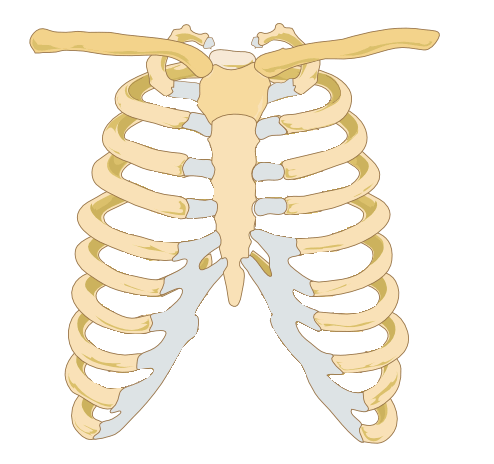Rib cage
(Redirected from False rib)
The rib cage is the protective bony framework that encloses the vital organs of the thoracic (chest) cavity. It serves as the primary structural support for the lungs, heart, and other essential organs located within the chest.
Anatomy of the Rib Cage[edit | edit source]
The rib cage primarily consists of:
- 12 pairs of ribs, each connected posteriorly to the vertebral column.
- The sternum (or breastbone) to which most of the ribs are connected anteriorly.
- Costal cartilages which connect the ribs to the sternum, ensuring flexibility.
Classification of Ribs[edit | edit source]
Ribs can be classified into three categories based on their attachment:
- True Ribs (1-7): These ribs attach directly to the sternum via costal cartilages.
- False Ribs (8-10): These do not directly connect to the sternum. Instead, their cartilages are attached to the cartilage of the rib above.
- Floating Ribs (11-12): These are not attached to the sternum at all. They are only connected to the vertebrae at the back.
Functions of the Rib Cage[edit | edit source]
- Protection: The rib cage safeguards vital organs like the heart, lungs, and liver from external trauma.
- Respiratory Assistance: It aids in the process of breathing, allowing for the expansion and contraction of the lungs.
- Structural Support: Provides a framework for the attachment of muscles associated with the chest, upper abdomen, and back.
- Facilitating Movement: Allows flexibility and movement of the upper body.
Clinical Significance[edit | edit source]
The rib cage plays a crucial role in clinical diagnostics and treatments. Several conditions and procedures associated with it include:
- Rib fractures: Often caused by trauma, these require medical attention due to potential damage to underlying organs.
- Costochondritis: Inflammation of the rib cartilage leading to chest pain.
- Thoracentesis: A procedure wherein a needle is inserted into the pleural space within the rib cage to remove excess fluid or air.
Evolutionary Perspective[edit | edit source]
From an evolutionary standpoint, the rib cage's design provides a balance between protection and flexibility, ensuring survival across various environmental conditions and physical challenges.
Conclusion[edit | edit source]
The rib cage, though often overlooked, plays a pivotal role in maintaining the structural integrity of the thoracic cavity and facilitating the vital functions of breathing and organ protection. Understanding its anatomy and function is crucial in the fields of medicine, anthropology, and evolutionary biology.
| This article is a medical stub. You can help WikiMD by expanding it! | |
|---|---|
| Bones of the torso | ||||||||||||||||
|---|---|---|---|---|---|---|---|---|---|---|---|---|---|---|---|---|
|
| Human regional anatomy | ||||||||||
|---|---|---|---|---|---|---|---|---|---|---|
|
Search WikiMD
Ad.Tired of being Overweight? Try W8MD's physician weight loss program.
Semaglutide (Ozempic / Wegovy and Tirzepatide (Mounjaro / Zepbound) available.
Advertise on WikiMD
|
WikiMD's Wellness Encyclopedia |
| Let Food Be Thy Medicine Medicine Thy Food - Hippocrates |
Translate this page: - East Asian
中文,
日本,
한국어,
South Asian
हिन्दी,
தமிழ்,
తెలుగు,
Urdu,
ಕನ್ನಡ,
Southeast Asian
Indonesian,
Vietnamese,
Thai,
မြန်မာဘာသာ,
বাংলা
European
español,
Deutsch,
français,
Greek,
português do Brasil,
polski,
română,
русский,
Nederlands,
norsk,
svenska,
suomi,
Italian
Middle Eastern & African
عربى,
Turkish,
Persian,
Hebrew,
Afrikaans,
isiZulu,
Kiswahili,
Other
Bulgarian,
Hungarian,
Czech,
Swedish,
മലയാളം,
मराठी,
ਪੰਜਾਬੀ,
ગુજરાતી,
Portuguese,
Ukrainian
Medical Disclaimer: WikiMD is not a substitute for professional medical advice. The information on WikiMD is provided as an information resource only, may be incorrect, outdated or misleading, and is not to be used or relied on for any diagnostic or treatment purposes. Please consult your health care provider before making any healthcare decisions or for guidance about a specific medical condition. WikiMD expressly disclaims responsibility, and shall have no liability, for any damages, loss, injury, or liability whatsoever suffered as a result of your reliance on the information contained in this site. By visiting this site you agree to the foregoing terms and conditions, which may from time to time be changed or supplemented by WikiMD. If you do not agree to the foregoing terms and conditions, you should not enter or use this site. See full disclaimer.
Credits:Most images are courtesy of Wikimedia commons, and templates, categories Wikipedia, licensed under CC BY SA or similar.
Contributors: Prab R. Tumpati, MD

